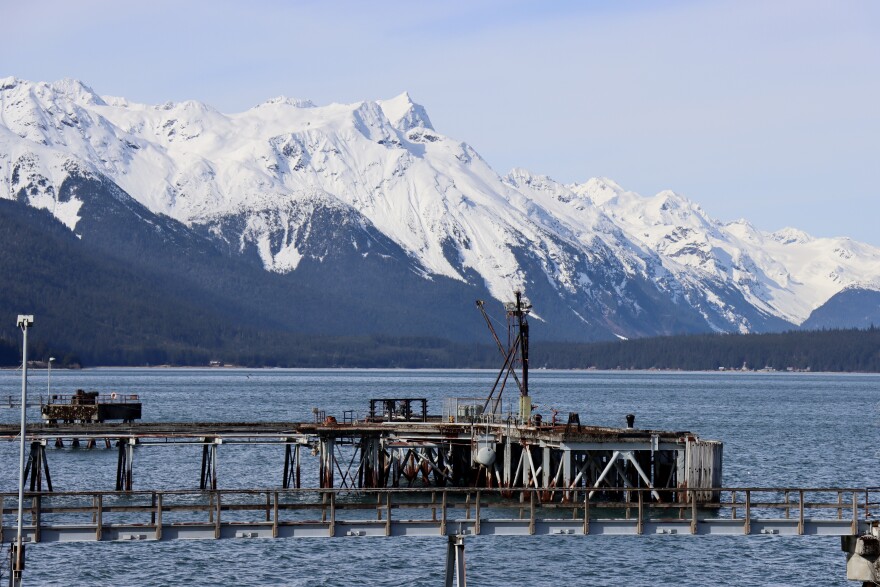Four years ago, an Oregon-based timber company won a contract to harvest some 23 million board feet of spruce and hemlock outside Haines. Now, the company’s plan to get that timber out of Alaska – and into buyers’ hands – is sparking pushback.
That’s because the company’s local operator is seeking permits to build a log transfer facility and storage site in Haines’ Lutak Inlet, a popular spot for commercial and subsistence fishing.
“We all fish right there,” said Erik Lembke, a commercial fisherman in Haines.
The concern pushed the State Department of Natural Resources to make an about-face late Wednesday afternoon by temporarily closing the permit application’s public comment period. The period was originally set to end on Friday.
Tony Keith, a natural resource manager with the department, said the feedback the agency had received so far made it clear the public needs more information. In response, the agency will require the company to provide the public with more details, including a dive survey of the ocean floor.
“Then, once you’re finishing the log transfer facility, or if you’re trying to bring it back under review or anything, you’re able to do another dive survey and go out there and check bark accumulation and stuff like that,” Keith said.
The Chilkat Valley’s first major timber sale in decades
The so-called Baby Brown timber sale lies in the Haines State Forest, just over 35 miles northwest of town between Porcupine and Jarvis Creeks. The state first awarded the sale to a contractor in 2016 but later canceled it after conservation groups appealed the land use plan. Later, in 2021, the sale was awarded again, this time to an Oregon-based company named NWFP Inc.
State Forester Greg Palmieri said the company has been developing what he called a “responsible plan” for the project over the last several years. As he sees it, Baby Brown presents a “huge opportunity” for Southeast and the Chilkat Valley specifically, which used to be home to a booming timber industry – but hasn’t seen a major sale in decades.
Palmieri said 8 million board feet of timber were harvested in the area in 1995, and there were a few other, smaller sales until about 2000. But he added that the last time there was a sale around the size of Baby Brown, “it was probably around the mid-70’s.”
“If there’s no industry working in the area, there’s no potential for growth. So this sale was designed to encourage the development of the industry,” Palmieri said. “Conceptually, does it crack that egg? We’ll have to see. It has the potential to do that.”
The contractor’s local operator – NSEA Timber Inc. – submitted the permit application on March 11, according to Keith of the Department of Natural Resources. The company also needs permits from the borough and U.S. Army Corps of Engineers.
The application proposes a log transfer facility and storage area on a 12-acre site about four miles out of town, off Lutak Road. The property is in a borough-designated waterfront industrial zone near the Alaska Marine Lines dock.
The facility would include a slide to transfer log bundles into the water. A boat would then place each bundle into a floating log raft and tow the raft to a storage site close to shore. Later, they would be loaded onto ships, which would transport them to buyers.
“This is a fundamental step in that process to get the product to market,” said Palmieri.
This type of facility has been around for decades, said Charles Nash, who used to be employed by the contractor but is no longer associated with the sale. Nash has worked in Alaska’s timber industry for years.
“There used to be log transfer facilities all over Southeast, and they come in many types. Some are slides, some are cranes,” he said. “But that’s how, generally, how logs got in the water.”
Palmieri, the forester, said the facility is a conservative option that aims to reduce traffic and limit impacts on the inlet – and the fisherman who use it. He estimated the storage site would be about 1,700-feet long, roughly one-third of a mile.
Fishing concerns
But some worry about the log rafts affecting water quality and access to the inlet.
“The way that you fish Lutak Inlet, you know, you fish out from the shoreline,” said Rafe McGuire, a commercial fisherman in Haines.
He added that a log area close to shore would mean fishermen would lose access to that area and more because they would need to make sure their nets wouldn’t get swept closer by the tide.
“You can’t fish very close to it. So you’d lose most of that distance,” McGuire said.
Lembke, the other fisherman, said there could be up to 20 boats fishing the area during the sockeye run.
“I think if there was a lot of logs and a big ship, it would pretty much make it impossible to do that,” he said
Polly Johannsen – who signed the permit application for the local operating company, NSEA Timber Inc. – did not respond to multiple requests for comment. Nicole Zeiser, area management biologist with the state Department of Fish and Game, did not respond to an emailed request for comment.
Earlier this month, a separate lumber company confirmed it was temporarily shutting down a work site near Kodiak. The company attributed the decision to China’s pause on imports of U.S. logs in response to ongoing trade disputes.
Palmieri says he’s received no indication that the trade war has affected the sale. The permit application, for its part, says logging could begin as soon as this spring and run through 2028. The agency did not say when the dive survey will take place or what the permitting delay will mean for logging operations.


